run flat PONTIAC BONNEVILLE 1993 Owners Manual
[x] Cancel search | Manufacturer: PONTIAC, Model Year: 1993, Model line: BONNEVILLE, Model: PONTIAC BONNEVILLE 1993Pages: 322, PDF Size: 16.31 MB
Page 5 of 322
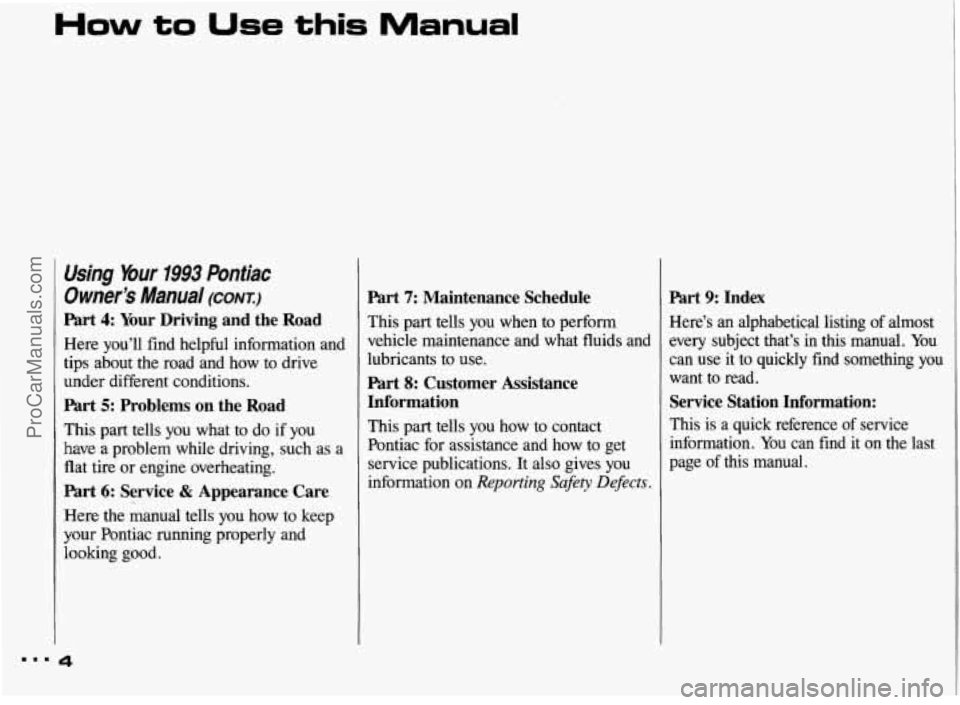
How to Use this Manual
Using bur 1993 Pontiac
Owner’s Manual (CONT.)
Part 4: Your Driving and the Road
Here you’ll find helpful information and
tips about the road and how to drive
under different conditions.
Part 5: Problems on the Road
This part tells you what to do if you
have a problem while driving, such as a
flat tire or engine overheating.
Part 6: Service & Appearance Care
Here the manual tells you how to keep
your Pontiac running properly and
looking good.
Part 7: Maintenance Schedule
This part tells you when to perform
vehicle maintenance and what fluids and
lubricants to use.
Part 8: Customer Assistance
Information
This part tells you how to contact
Pontiac for assistance and how to get
service publications. It also gives you
information on
Reporting Safety Defects.
Part 9: Index
Here’s an alphabetical listing of almost
every subject that’s
in this manual. You
can use it to quickly find something you
want to read.
Service Station Information:
This is a quick reference of service
information. You can find it on the last
page of this manual.
.I. 4
ProCarManuals.com
Page 25 of 322
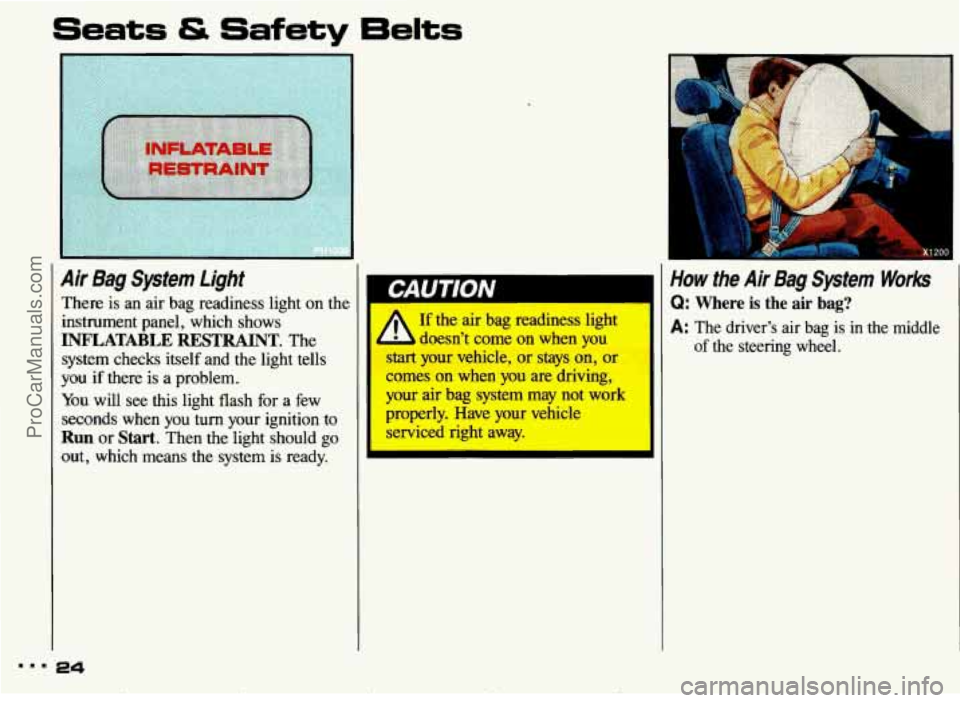
Seats & Safety 6elts
Air Bag System Light
There is an air bag readiness light on the
instrument panel, which shows
INFLATABLE RESTRAINT. The
system checks itself and the light tells
you if there is a problem.
You will see this light flash for a few
seconds when you turn your ignition to
Run or Start. Then the light should go
out, which means the system is ready.
If the air bag readiness light
L b doesn’t come on when you
s t your vehicle, or stays on, or
comes on when you are driving,
your air bag system may
not work
properly. Have your vehicle serviced right away.
4
3
How the Air Bag System Works
Q: Where is the air bag?
A: The driver’s air bag is in the middle
of the steering wheel.
ProCarManuals.com
Page 57 of 322
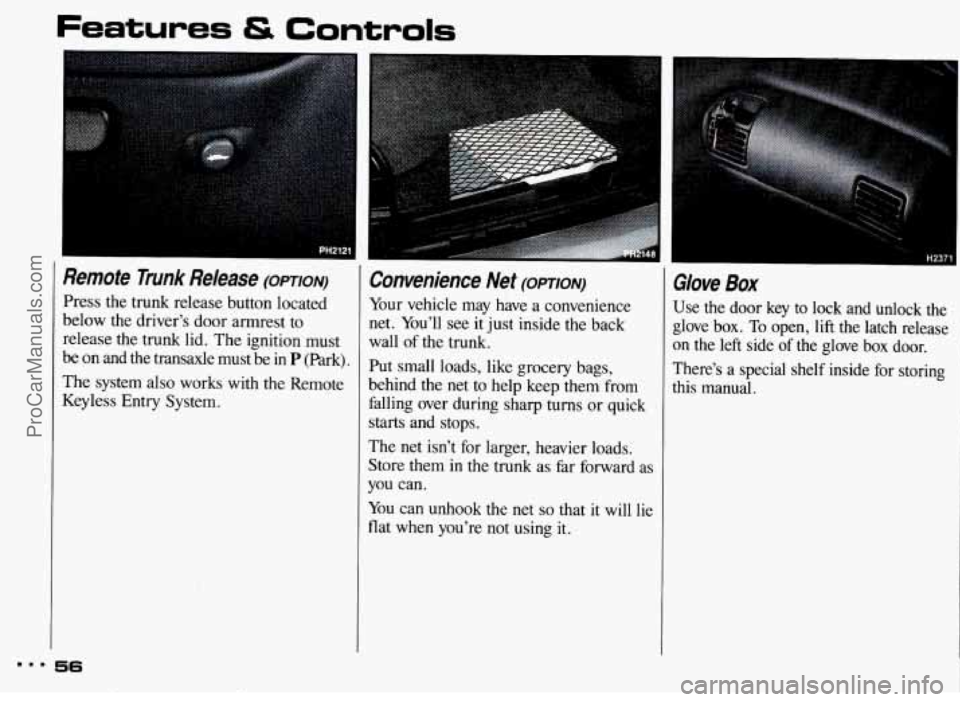
Remote Trunk Release (opTIoN)
Press the trunk release button located
below the driver’s door armrest
to
release the trunk lid. The ignition must
be
on and the transaxle must be in P (Park).
The system also works with the Remote
Keyless Entry System.
Convenience Net (OPTION)
Your vehicle may have a convenience
net. You’ll see it just inside the back
wall of the trunk.
Put small loads, like grocery bags,
behind
the net to help keep them from
falling over during sharp turns or quick
starts and stops.
The net isn’t for larger, heavier loads.
Store them in the trunk as far forward as
you can.
You can unhook the
net so that it will lie
flat when
you’re not using it.
Glove Box
Use the door key to lock and unlock the
glove box.
To open, lift the latch release
on the left side of the glove box door.
There’s a special shelf inside for storing
this manual.
m.. 56
ProCarManuals.com
Page 209 of 322
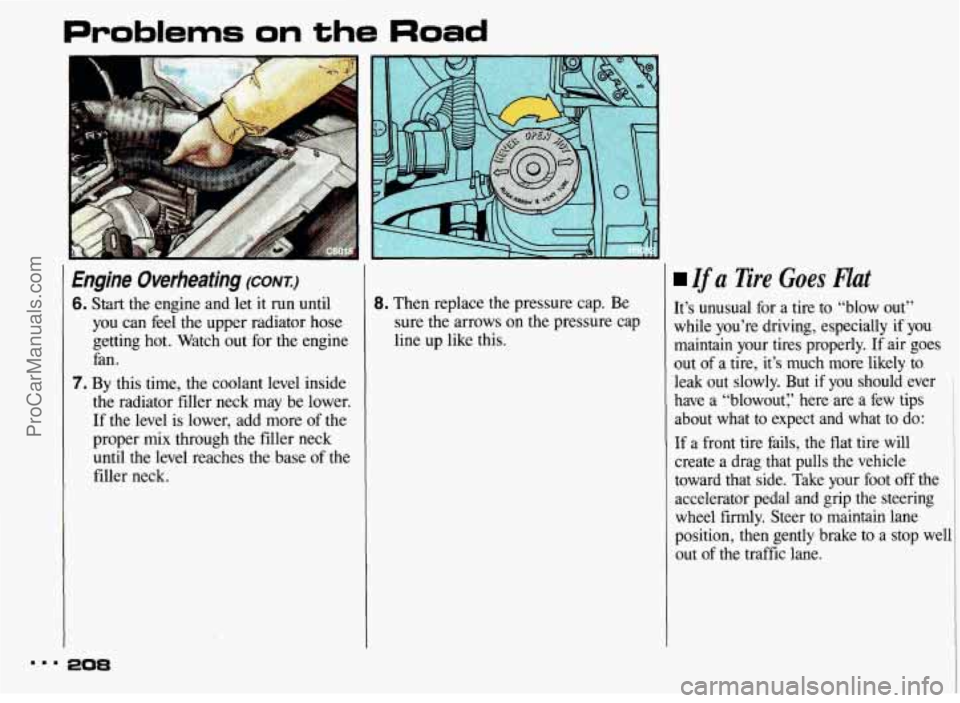
Problems on the Road
I Engine Overheating (CONT.)
6. Start the engine and let it run until
you can feel the upper radiator hose
getting hot. Watch out for the engine
fan.
7. By this time, the coolant level inside
the radiator filler neck may be lower.
If the level is lower, add more of the
proper mix through the filler neck
until the level reaches the base of the
filler neck.
8. Then replace the pressure cap. Be
sure the arrows on the pressure cap
line up like this.
Ifa Tire Goes Flat
It’s unusual for a tire to “blow out”
while you’re driving, especially if you
maintain your tires properly. If air goes
out of a tire, it’s much more likely to
leak out slowly. But
if you should ever 1
have a “blowout:’ here are a few tips
about what to expect and what to do:
If a front tire fails, the flat tire will
create a drag that pulls
the vehicle
toward that side. Take your foot off the accelerator pedal and grip the steering
wheel firmly. Steer
to maintain lane
position,
then gently brake to a stop well
out of the traffic lane.
ProCarManuals.com
Page 210 of 322
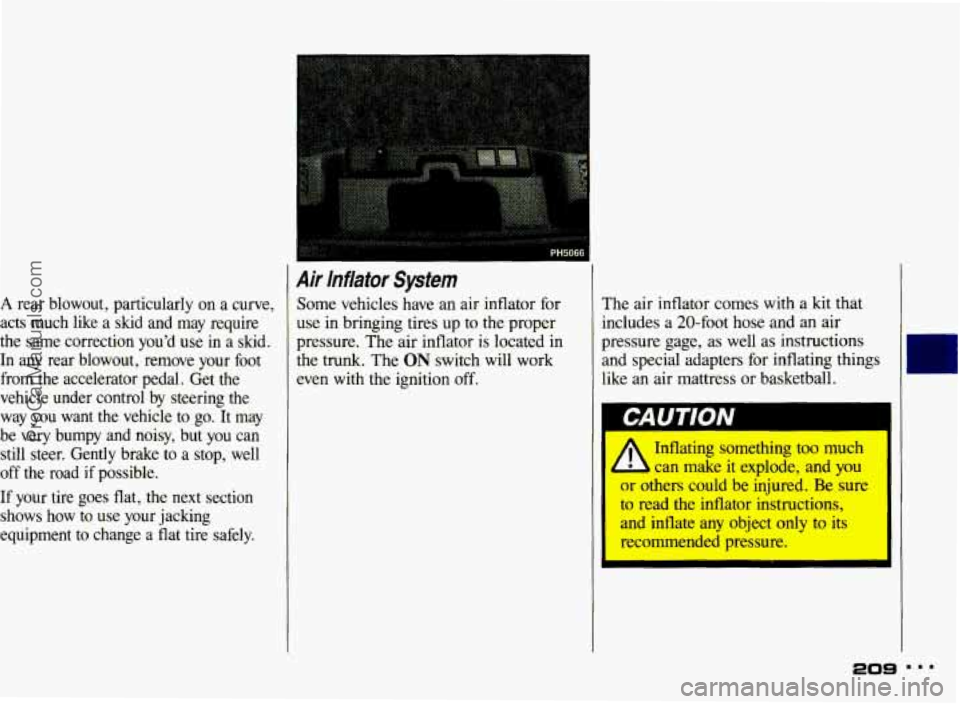
A rear blowout, particularly on a curve,
acts much like a skid and may require
the same correction you'd use in a skid.
In any rear blowout, remove your foot from the accelerator pedal. Get the
vehicle under control by steering the
way you want the vehicle to
go. It may
be very bumpy and noisy, but you can
still steer, Gently brake to a stop, well
off the road
if possible.
If your tire goes flat, the next section
shows how to use your jacking
equipment to change a flat tire safely.
Air lnflator Sysfem
Some vehicles have an air inflator for
use in bringing tires up to the proper
pressure. The air inflator is located in
the trunk. The
ON switch will work
even with the ignition off. The air
inflator comes with
a kit that
includes a 20-foot hose and an air
pressure gage, as well as instructions
and special adapters for inflating things
like an air mattress or basketball.
Inflating something too much
can make it explode, and
you
or others could be injured. Be sure
to read the inflator instructions,
and inflate any object only
to its
1 recommended pressure.
1
I 209
ProCarManuals.com
Page 218 of 322
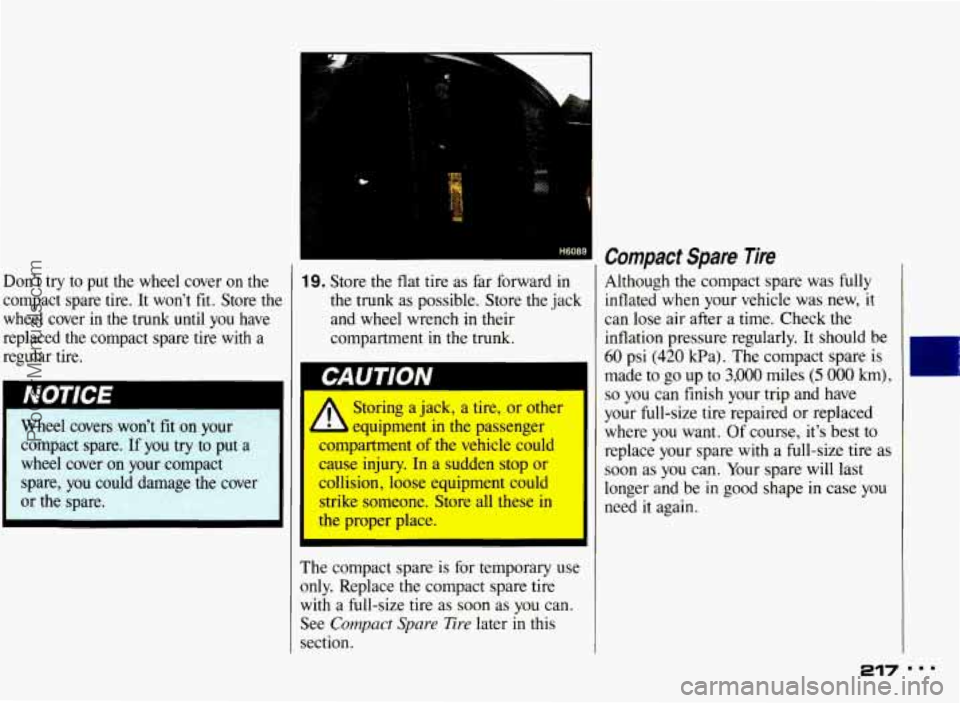
Don’t try to put the wheel cover on the
compact spare tire. It won’t
fit. Store the
wheel cover in the trunk until you have
replaced the compact spare tire with a
regular tire.
Wheel covers won’t fit on your
compact spare. If you try to put
a
wheel cover on your compact
spare, you could damage the cover
or the spare.
19. Store the flat tire as far forward in
the trunk as possible. Store the jack
and wheel wrench
in their
compartment in the trunk.
1 Storing a jack, a tire, or other
equipment in the passenger
compartment of the vehicle could
cause injury. In a sudden stop or
collision, loose equipment could
strike
someone. Store all these in
I the proper place.
The compact spare is for temporary use
only. Replace the compact spare tire
with a full-size tire as soon as you can.
See
Compact Spare Tire later in this
section.
Compact Spare Tire
Although the compact spare was fully
inflated when your vehicle was new, it
can lose air after a time. Check the
inflation pressure regularly. It should be
60 psi (420 kPa). The compact spare is
made to
go up to 3,000 miles (5 000 km),
so you can finish your trip and have
your full-size tire repaired
or replaced
where you want. Of course, it’s best to replace your spare with
a fill-size tire as
soon as you can. Your spare will last
longer and be
in good shape in case you
need it again.
r
ProCarManuals.com
Page 249 of 322
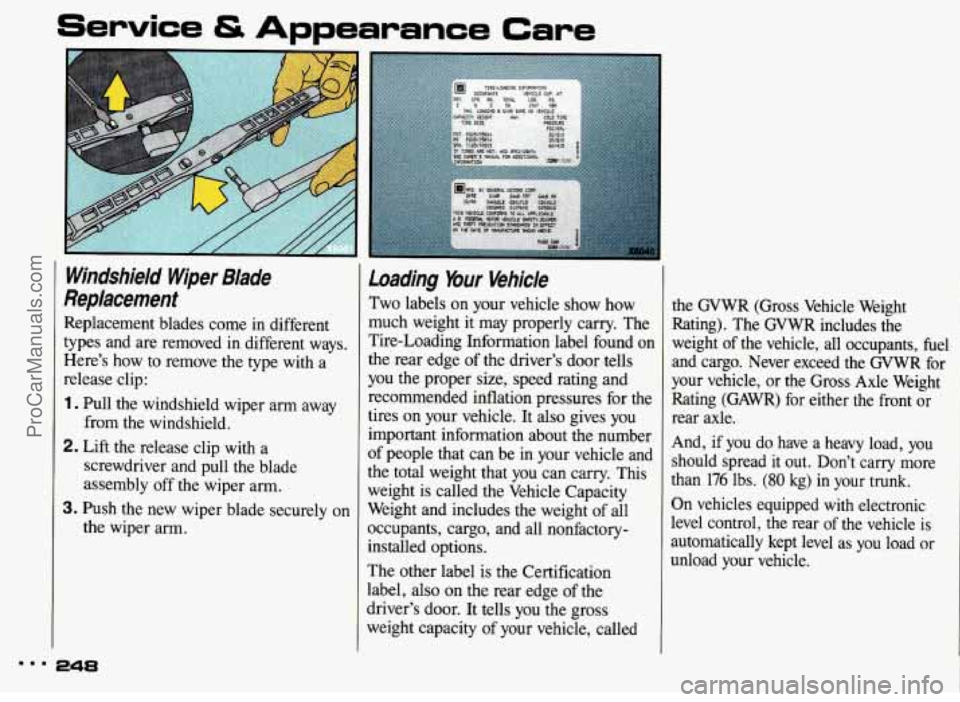
Service & Appearance Care
Windshield Wiper Blade
Replacement
Replacement blades come in different
types and are removed
in different ways.
Here’s how to remove the type with a
release clip:
1. Pull the windshield wiper arm away
2. Lift the release clip with a
from
the windshield.
screwdriver and pull the blade
assembly off the wiper arm.
the wiper arm.
3. Push the new wiper blade securely on
Loading bur Vehicle
Two labels on your vehicle show how
much weight it may properly carry. The
Tire-Loading Information label found on
the rear edge of the driver’s door tells
you the proper size, speed rating and
recommended inflation pressures for the
tires on your vehicle. It also gives you
important information about the number
of people that can be in your vehicle and
the total weight that you can carry. This
weight is called the Vehicle Capacity
Weight and includes the weight of all
occupants, cargo, and all nonfactory-
installed options.
The other label is the Certification
label,
also on the rear edge of the
driver’s door. It tells you the gross
weight capacity of your vehicle, called the
GVWR (Gross Vehicle Weight
Rating). The GVWR includes the
weight of the vehicle, all occupants, fuel
and cargo. Never exceed the GVWR for
your vehicle, or
the Gross Axle Weight
Rating (GAWR) for either the front or
rear axle.
And, if you do have a heavy load,
you
should spread it out. Don’t carry more
than
176 lbs. (80 kg) in your trunk.
On vehicles equipped with electronic
level control, the rear of the vehicle
is
automatically kept level as you load or
unload your vehicle.
... 248
ProCarManuals.com
Page 268 of 322
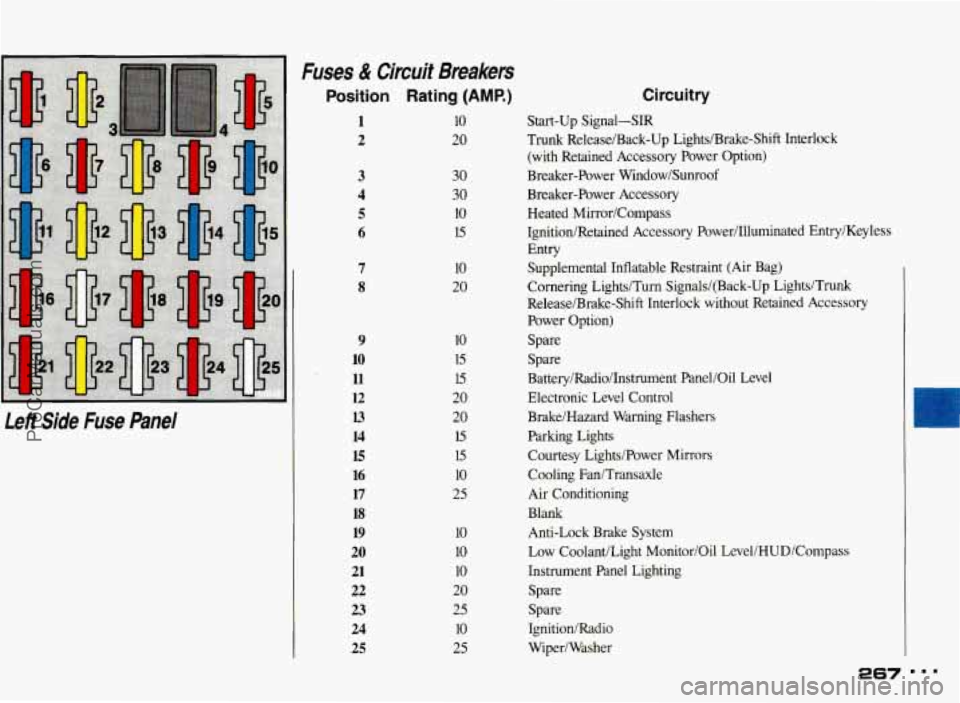
Left Side Fuse Panel Fuses
& Circuit Breakers
Position Rating (AMP.)
7
8
9
10
ll
12
13
14
15
16
17 18
19
20 21
22
23 24
25
10
20
30
30
10
15
10
20
10
15
15
20
20
15
15
10
25
10
10
10
20
25
10
25
Circuitry
Start-up Signal-SIR
Trunk Release/Back-Up Lights/Brake-Shift Interlock (with Retained Accessory Power Option)
Breaker-Power Window/Sunroof
Breaker-Power Accessory Heated Mirror/Compass
IgnitiodRetained Accessory Power/Illuminated EntryKeyless
Entry
Supplemental Inflatable Restraint (Air Bag)
Cornering Lights/Turn Signals/(Back-Up Lights/Trunk
Release/Brake-Shift Interlock without Retained Accessory Power Option)
Spare
Spare
Battery/Radio/Instrument Panel/Oil Level
Electronic Level Control
Brake/Hazard Warning Flashers Parking Lights Courtesy Lights/Power Mirrors
CooIing Fan/Transaxle
Air Conditioning
Blank Anti-Lock Brake System Low Coolant/Light Monitor/Oil Level/HUD/Compass
Instrument Panel Lighting Spare
Spare
IgnitiodRadio
WipedWasher
267
ProCarManuals.com
Page 316 of 322
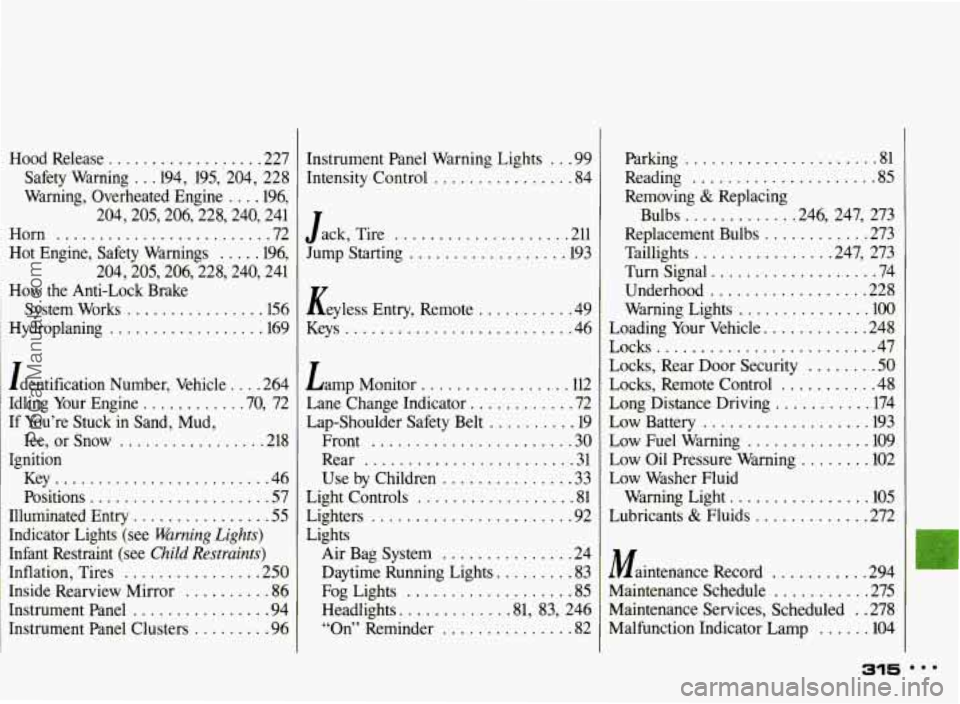
Hood Release .................. 227
Safety Warning
.. .194. 195. ’ 204. 228
Warning. Overheated Engine
... .196.
204.205.206.228.240. 241
Horn
......................... 72
Hot Engine. Safety Warnings
.... .196.
204.205.206.228.240. 241
How the Anti-Lock Brake
System Works
............... -156
Hydroplaning
.................. 169
Identification Number. Vehicle
.... 264
If You’re Stuck in Sand. Mud.
Ignition Idling Your Engine
........... .70.
72
Ice. or Snow
................. 218
Key
......................... 46
Positions
..................... 57
Illuminated Entry
................ 55
Inflation. Tires
................ 250
Indicator Lights (see
Warning
Lights)
Infant Restraint (see Child Restraints)
Inside Rearview Mirror .......... 86
Instrument Panel
................ 94
Instrument Panel Clusters
......... 96
Instrument Panel Warning Lights ... 99
Intensity Control
................ 84
.................... J ack. Tire 211
Jump Starting
.................. 193
Keyless Entry. Remote
........... 49
Keys
.......................... 46
Lamp Monitor
................. 112
Lane Change Indicator
............ 72
Lap-Shoulder Safety Belt
.......... 19
Front
....................... 30
Rear
........................ 31
Use by Children
............... 33
Light Controls
.................. 81
Lighters
....................... 92
Air Bag System
............... 24
Daytime Running Lights
......... 83
Fog Lights
................... 85
Headlights
............ .81, 83, 246
“On” Reminder
............... 82
Lights Parking
...................... 81
Reading
..................... 85
Removing
& Replacing
Bulbs
............ .246. 247. 273
Replacement Bulbs
............ 273
Taillights
............... .247. 273
Turn Signal
................... 74
Underhood
.................. 228
Warning Lights
............... 100
Loading Your Vehicle
............ 248
Locks
......................... 47
Locks. Rear Door Security
........ 50
Locks. Remote Control ........... 48
Long Distance Driving
........... 174
Low Battery
................... 193
Low Fuel Warning
.............. 109
Low Oil Pressure Warning
........ 102
Low Washer Fluid Warning Light
................ 105
Lubricants & Fluids ......... 272
Maintenance Record
........... 294
Maintenance Schedule
........... 275
Maintenance Services. Scheduled
. . 278
Malfunction Indicator Lamp
...... 104
ProCarManuals.com